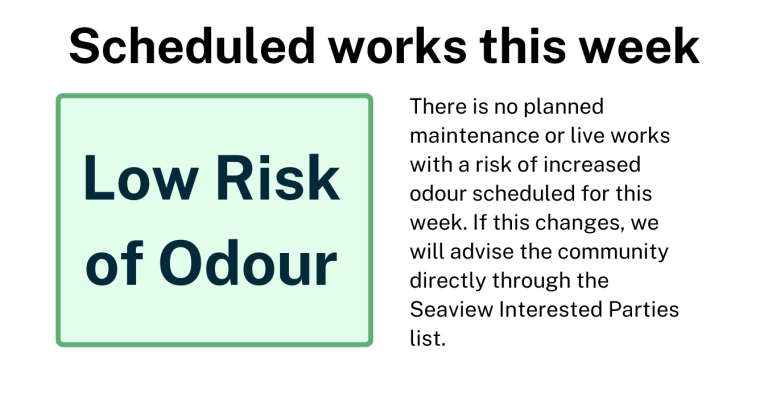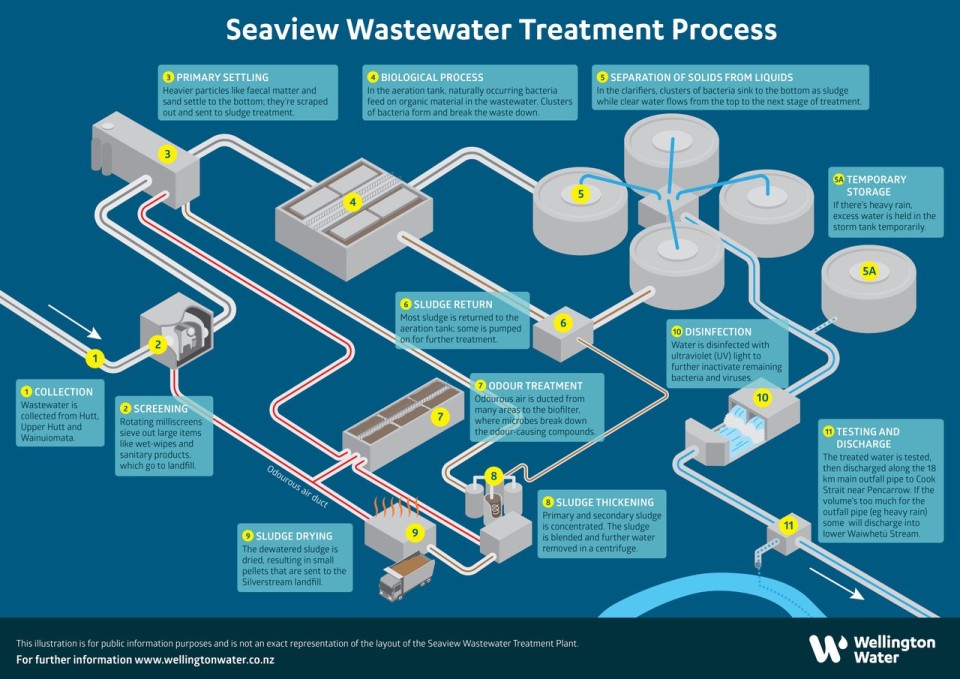Seaview Wastewater Treatment Plant
The Seaview Wastewater Treatment Plant serves a population of about 160,000 in Upper Hutt, Lower Hutt and Wainuiomata. The wastewater is treated or cleaned through a series of screens, tanks, bioreactors, clarifiers and ultraviolet treatments before being discharged into the open sea near near Pencarrow Head / Te Raeakiaki where it is quickly diluted.
Odour level indicators
The level of odour experienced by the community is influenced by many internal and external factors.
With all these variables, odour can't be forecast with a high level of confidence.
What we can do is monitor the internal factors at the plant which can give an indication of possible odour, and communicate these clearly.
The health and balance of the plant
Seaview Wastewater Treatment Plant uses a biological process to help treat wastewater, which we work to keep healthy and balanced. This process is complex, with a number of factors. Two of these are Mixed Liquor Suspended Solids and Dissolved Oxygen levels. We use these to help give an insight into how the biological process is managed. We'll update these every month in the graphs below, where green indicates the standard target range for these factors at Seaview Wastewater Treatment Plant. Please note that these ranges are not the same at every treatment plant.
When they are within or close to the target range, it is a good indication that we can expect odour to be at a minimum, unless there is an operational issue at the plant. However, some external factors (i.e. a weather event impacting the flow of wastewater into the plant) may require the team to make the levels higher or lower in order to keep the biological process balanced and healthy.
Plant maintenance and operations
Seaview is an aging plant, with routine operations and maintenance occurring every day, and unplanned urgent maintenance commonly needed to address issues as they crop up. Major project work is intermittent as we continue to address odour and work to upgrade the dryer.
All of these can affect the level of odour experienced by the community, so we work to keep people as up-to-date as possible with all the plant's maintenance and operations. You can find the latest information here under 'Updates'.
Odour Update
Did you know? The direction of the wind can impact where odour is experienced. Commonly, a northerly impacts residents of the southern suburbs, while a southerly can carry odour up the valley where it affects residents in the northern suburbs. The weather forecast can let you know what way the wind will be blowing.

Join the Seaview mailing list
Sign up if you want to receive notifications and updates about the plant
Seaview Newsletter
Find more information about plant activity and projects
Odour Project
Learn more about the ongoing works to reduce odour at Seaview Wastewater Treatment Plant
Making a complaint
If you have a complaint about Wellington Water directly, please call 04 912 4470 or email customer@wellingtonwater.co.nz to access our free complaints process.
After hours, please contact the Hutt City Council Call Centre on 04 570 6666 / 0800 488 824.
Greater Wellington Regional Council is the regulatory agency for reporting airborne discharges 0800 496 734.
Complaints to the Seaview Wastewater Treatment plant can be sent to the following contact details:
First point of contact: Veolia Duty Manager - Call 0800 928 371.
Veolia's Duty Manager contact number operates 24/7 as such complaints can be directly forwarded to them especially if the complaint is urgent and/or happened after office hours.
When a complaint is received, the following information will be recorded:
- Name
- Contact details of the customer
- Nature of the complaint
- Date and time
- Location
Complaints shall be actioned within 24 hours upon receipt and the records being written to the plant's operational incident log. Odour and/or wastewater discharge complaints will be forwarded to the regional council.
Plant performance
![]()
Current status: Non-compliant
Period: June 2025
Commentary:
The plant moved back into compliance for faecal coliforms(90-day percentile) in June but became non-compliant for suspended solids(90-day percentile).The plant remains compliant for biochemical oxygen demand.
Discharges:
There were four discharges to the Waiwhetū Stream in June.
Odour Complaints
No odour complaints in June.
Items of significance:
Effluent - Non-compliance
Several wet weather events over the past couple of month shave affected daily effluent quality resulting in this non-compliance. An improvement in the weather is expected to enable the daily results to recover and the 90-day suspended solids percentile to move back into compliance.
Thermal Dyer - Planned shutdown
The two-week shutdown of the dryer took place successfully carrying out essential maintenance on several major components concurrently is critical to maintain the dryers’ operational performance.
Odour Treatment Project
What has been completed:
- HEB Construction have established their site at the WWTP
- Long lead items for Stage 2 works have been ordered
- Odours couting was undertaken during the recent dryer shutdown
What is coming up:
- The contract or design to be completed and approved by Wellington Water
- The new community odour monitors to be installed (by end September), and website interface completed
- Physical works to commence on Stage 2
Read the full June 2025 Seaview wastewater treatment plant monthly performance report.
Resource consents
WGN050359 [24539] Discharge Treated Wastewater to Coastal Marine Area (Seaview WWTP)
WGN120142 [31740] Construction to Coastal Marine Area Maintenance (Seaview WWTP)
WGN120142 [33406] Discharge of Treated WW to Fresh Water Wet Weather (Seaview WWTP)
WGN120142 [33407] Discharge of Treated WW to Coastal Marine Area Maintenance (Seaview WWTP)
WGN120142 [33408] Discharge Treated Wastewater to Stream (Seaview WWTP)
WGN930193 [1] Contaminants Discharge to Air Outfall Structure (Seaview WWTP)
WGN930193 [2] Contaminants Discharge to Air Venting Structure (Seaview WWTP)
WGN950162 [1] Contaminants Discharge to Air WWTP (Seaview WWTP)
WGN930194 Land Occupation by Outfall Pipeline and Structures (Seaview WWTP)
Compliance reports
Seaview Wastewater Treatment Plant - 2021 2022 Compliance Report
Seaview Wastewater Treatment Plant - Consent Compliance Report 2022 - 2023
Seaview Wastewater Treatment Plant - Consent Compliance Report 2023 - 2024
Resource consent reports
Annual Reports:
Seaview Wastewater Treatment Plant Annual Resource Consents Report 2024/25
Seaview Wastewater Treatment Plant Annual Resource Consents Report 2023-24
Seaview Wastewater Treatment Plant Annual Resource Consents Report 2022/ 23
Seaview Wastewater Treatment Plant Annual Resource Consents Report 2021/2022
Seaview Wastewater Treatment Plant Annual Resource Consents Report 2020/2021
Seaview Wastewater Treatment Plant and HCC/UHCC Trunk Main Annual Resource Consents Report 2019/2020
Quarterly Reports:
Seaview Wastewater Treatment Plant - January - March 2025 - Quarterly Resource Consents Report
Seaview Wastewater Treatment Plant October - December 2024 - Quarterly Resource Consents Report
Seaview Wastewater Treatment Plant July - September 2024 - Quarterly Resource Consents Report
Seaview Wastewater Treatment Plant January - March 2023 - Quarterly Resource Consents Report
Appendices:
Appendix IV - Annual Resource Consents Report - Hutt Valley Tradewaste Report 2024/25
Appendix V - Annual Resource Consents Report - AEE Waiwhetu Stream Wet Weather Discharges 2024/25
Appendix VI - Annual Resource Consents Report - AEE Non-compliant Discharges 2024/25
Seaview Wastewater Treatment Plant Annual Consents Report 2023-24 - Appendix ||| Trade Waste
Public health statements on the use of the treatment plant odour neutraliser
Summary
Potential health concerns associated with exposure to quaternary ammonium compounds are most likely associated with direct contact with undiluted product i.e. the staff preparing the solution. Staff exposure risk is managed by following the correct health and safety procedures. Quaternary ammonium compounds are often part of household cleaning and disinfection products and so exposure to the public is relatively common. Given the level of dilution of the product used in the cannon, and the distance between the placement of the cannon and potential locations for public exposure (typically this type of cannon dispersal method has an estimated droplet range of 50-100 metres) that effectively dilutes the strength further, we would not expect this to represent a health risk for the general public.
Te Whatu Ora - Health NZ - April 2023
_________________________________
In May 2024, The plant operator, Veolia, switched to a new product Odour Neutraliser Plus (SCD1100) which is manufactured by biOx Environmental. This is a stabilised chlorine dioxide product that oxidises odour molecules such as Hydrogen Sulfide. The product is safe when used as directed and is utilised in wastewater treatment plants, landfills and transfer stations throughout New Zealand. While the previous product Hi Chem Disinfectant Reodorant presented no public health risks (see above) we decided to act on complaints from the community about the odour it generates and changed to Odour Neutraliser Plus (SCD1100). More information about this product
Independent assessment on the impact of the odour neutralisers
Regarding any impact of the odour neutralisers, an independent assessment has been undertaken and the report concluded that the potential health risks regarding the use of the odour deodorisers are low and acceptable in accordance with New Zealand Guidelines. A copy of the report can be found here.
Odour Investigation Reports
Consents
One of the nine resource consents permitting the operation of the plant, consent ‘WGN120142 [33408] Discharge Treated Wastewater to Stream ' expired in 2018.
Prior to the expiry of this consent, Hutt City Council applied to Greater Wellington Regional Council (GWRC) for a new consent to temporarily discharge treated wastewater to the Waiwhetū Stream.
While the reconsenting is underway, we continue to operate under the existing consent.
In general, the consents allow Hutt City Council to:
-
discharge treated and partially treated effluent through an existing outfall,
-
discharge mixed disinfected, treated and milli-screened wastewater during and/or immediately after heavy rainfall,
-
discharge mixed disinfected, treated and milli-screened wastewater during maintenance,
-
discharge of contaminants to the air, and
-
to occupy the stream and coastal marine area with an outfall structure.





